pep小学英语优秀教案
- 格式:docx
- 大小:10.54 KB
- 文档页数:7
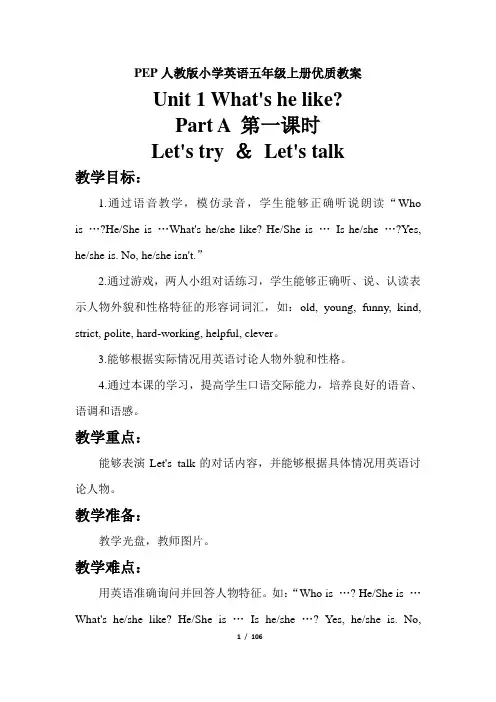
PEP人教版小学英语五年级上册优质教案Unit 1 What's he like?Part A 第一课时Let's try &Let's talk教学目标:1.通过语音教学,模仿录音,学生能够正确听说朗读“Who is …?He/She is …What's he/she like? He/She is …Is he/she …?Yes, he/she is. No, he/she isn't.”2.通过游戏,两人小组对话练习,学生能够正确听、说、认读表示人物外貌和性格特征的形容词词汇,如:old, young, funny, kind, strict, polite, hard-working, helpful, clever。
3.能够根据实际情况用英语讨论人物外貌和性格。
4.通过本课的学习,提高学生口语交际能力,培养良好的语音、语调和语感。
教学重点:能够表演Let's talk的对话内容,并能够根据具体情况用英语讨论人物。
教学准备:教学光盘,教师图片。
教学难点:用英语准确询问并回答人物特征。
如:“Who is …? He/She is …What's he/she like? He/She is …Is he/she …? Yes, he/she is. No,he/she isn't.”教学过程:Step 1: Warm up1. Show teachers' pictures and ask them who these teachers are.2. Discuss about their teachers.3. Let's listen and sing “Who's your teacher?”Step 2: Presentation1.Listen and tick,听录音了解Oliver 和Wu Yifan的老师。

人教版pep小学英语六年级上册_新pep小学英语六年级上册教案(优秀8篇)新pep小学英语六年级上册教案篇一教学目标知识目标:能够进行物品归属的问话与答语,并能根据物体的远近,正确使用this和that。
能力目标:能听懂,会说要求的单词和句子情感价值:进一步提高对英语学习的热情,培养更加稳定的学习兴趣。
能积极主动地参与课堂活动,在情景对话中大胆开口,主动模仿。
教学重点学习和练习正确书写四会单词和四会句子。
教学难点正确使用代词this和that。
课时数 2教学过程 1.热身 / 复习(Warming-up / Revision)1)播放课本附录中的歌曲I want to be your friend, 渲染课堂气氛。
2)把小动物面具挂在墙上,让学生说出它们是什么动词,是谁的。
2.新课导入(Presentation)1)展示本课教学挂图,让学生观察,并提出问题:What are Peter and Lisa doing?What are they talking about?2)播放本课录音,让学生听,然后讨论自己的猜测是否正确。
3)再放录音,让学生仔细听:谁扮演bear?谁的头饰找不到了?最后找到了吗?4)指导学生跟读录音。
5)让学生四人一组分角色表演会话。
6)鼓励学生戴面具到讲台上来表演。
3.趣味操练(Practice)1)教师将全班划分成6~8个小组,每组发一张白纸,每张白纸的最上面都写有“失物招领处”。
要求每组画出3~4种物品,供其它组认领。
2)每组分成两部分,一部分当失主去其它组找丢失物品,另一部分留在本组提供物品。
用所学句型进行交际活动。
3)播放本课投影片,让学生边看边配音。
4. 拓展活动(Additional activities)1)回家听本课录音,模仿语音语调。
2)把本课对话改编或故事,讲给父母听。
课后反思新pep小学英语六年级上册教案篇二教学功能:Talking about past activitiesTarget Language: Did you…?Yes, I did. / No, I didn’t.教学目标:Vocabulary: dear, met (meet), ran (run)Pronunciation: /i:/, /I/, /e/, / /Song: Where did you go?教学过程:一、Warm-up1. Review verb phrases.2. Review Unit 1.二、Introduction1. Prepare a postcard with a picture of own city and ask the children: What’s this? What is the place? What can you see?2. Show the back of the postcard and tell the children that Lingling wrote a letter on it.三、Presentation1. Play the cassette and pause after each utterance for the children to repeat and tick the actions: went to the park, met John, bought ice creams, went home, ran to the bus, dropped.2. Play the cassette again and ask the children answer the following questions: Who wrote the postcard? Whom did Lingling send the postcard to?3. Write down the words: met, bought, went, ran, dropped and ask the children to guess the original form.4. Finish activity 2. Ask the children to ask and answer in pairs.四、Sing a song1. Ask the children to look at the pictures carefully.2. Play the cassette and ask the children to listen carefully.3. Teach the sentences of the song one by one.4. Play the cassette several times and ask the children to sing along.五、Homework1. Read the letter and sing the song.2. Finish activity 6: sentence relay.2021版pep小学英语六年级上册教案篇三单元教学目标1、能力目标(1)能听懂会说认读本单元关于形容词比较级的单词。
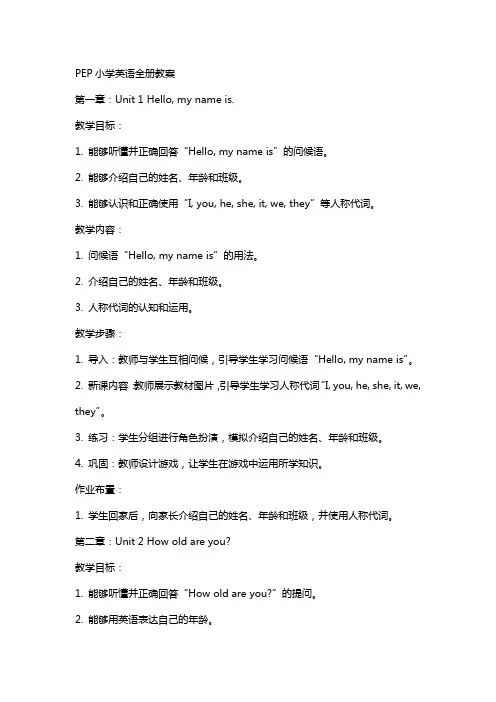
PEP小学英语全册教案第一章:Unit 1 Hello, my name is.教学目标:1. 能够听懂并正确回答“Hello, my name is”的问候语。
2. 能够介绍自己的姓名、年龄和班级。
3. 能够认识和正确使用“I, you, he, she, it, we, they”等人称代词。
教学内容:1. 问候语“Hello, my name is”的用法。
2. 介绍自己的姓名、年龄和班级。
3. 人称代词的认知和运用。
教学步骤:1. 导入:教师与学生互相问候,引导学生学习问候语“Hello, my name is”。
2. 新课内容:教师展示教材图片,引导学生学习人称代词“I, you, he, she, it, we, they”。
3. 练习:学生分组进行角色扮演,模拟介绍自己的姓名、年龄和班级。
4. 巩固:教师设计游戏,让学生在游戏中运用所学知识。
作业布置:1. 学生回家后,向家长介绍自己的姓名、年龄和班级,并使用人称代词。
第二章:Unit 2 How old are you?教学目标:1. 能够听懂并正确回答“How old are you?”的提问。
2. 能够用英语表达自己的年龄。
3. 能够认识和正确使用“I, you, he, she, it, we, they”等人称代词。
教学内容:1. 提问年龄的用法“How old are you?”。
2. 表达自己年龄的方式。
3. 人称代词的认知和运用。
教学步骤:1. 导入:教师与学生互相问候,引导学生学习问候语“How old are you?”。
2. 新课内容:教师展示教材图片,引导学生学习人称代词“I, you, he, she, it, we, they”。
3. 练习:学生分组进行角色扮演,模拟回答“How old are you?”的问题。
4. 巩固:教师设计游戏,让学生在游戏中运用所学知识。
作业布置:1. 学生回家后,向家长提问并回答“How old are you?”的问题。
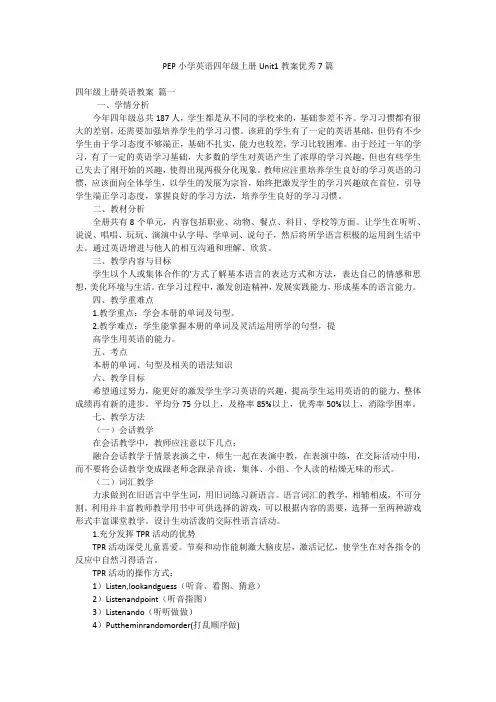
PEP小学英语四年级上册Unit1教案优秀7篇四年级上册英语教案篇一一、学情分析今年四年级总共187人,学生都是从不同的学校来的,基础参差不齐。
学习习惯都有很大的差别,还需要加强培养学生的学习习惯。
该班的学生有了一定的英语基础,但仍有不少学生由于学习态度不够端正,基础不扎实,能力也较差,学习比较困难。
由于经过一年的学习,有了一定的英语学习基础,大多数的学生对英语产生了浓厚的学习兴趣,但也有些学生已失去了刚开始的兴趣,使得出现两极分化现象。
教师应注重培养学生良好的学习英语的习惯,应该面向全体学生,以学生的发展为宗旨,始终把激发学生的学习兴趣放在首位,引导学生端正学习态度,掌握良好的学习方法,培养学生良好的学习习惯。
二、教材分析全册共有8个单元,内容包括职业、动物、餐点、科目、学校等方面。
让学生在听听、说说、唱唱、玩玩、演演中认字母、学单词、说句子,然后将所学语言积极的运用到生活中去。
通过英语增进与他人的相互沟通和理解、欣赏。
三、教学内容与目标学生以个人或集体合作的'方式了解基本语言的表达方式和方法,表达自己的情感和思想,美化环境与生活。
在学习过程中,激发创造精神,发展实践能力,形成基本的语言能力。
四、教学重难点1.教学重点:学会本册的单词及句型。
2.教学难点:学生能掌握本册的单词及灵活运用所学的句型,提高学生用英语的能力。
五、考点本册的单词、句型及相关的语法知识六、教学目标希望通过努力,能更好的激发学生学习英语的兴趣,提高学生运用英语的的能力,整体成绩再有新的进步。
平均分75分以上,及格率85%以上,优秀率50%以上,消除学困率。
七、教学方法(一)会话教学在会话教学中,教师应注意以下几点:融合会话教学于情景表演之中,师生一起在表演中教,在表演中练,在交际活动中用,而不要将会话教学变成跟老师念跟录音读,集体、小组、个人读的枯燥无味的形式。
(二)词汇教学力求做到在旧语言中学生词,用旧词练习新语言。
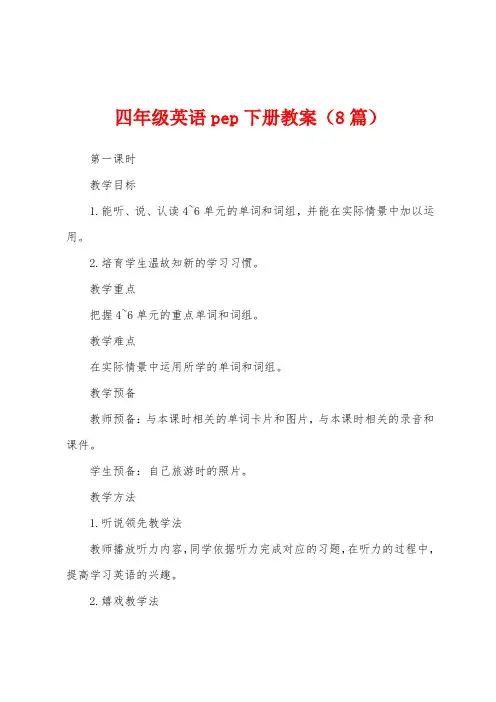
四年级英语pep下册教案(8篇)第一课时教学目标1.能听、说、认读4~6单元的单词和词组,并能在实际情景中加以运用。
2.培育学生温故知新的学习习惯。
教学重点把握4~6单元的重点单词和词组。
教学难点在实际情景中运用所学的单词和词组。
教学预备教师预备:与本课时相关的单词卡片和图片,与本课时相关的录音和课件。
学生预备:自己旅游时的照片。
教学方法1.听说领先教学法教师播放听力内容,同学依据听力完成对应的习题,在听力的过程中,提高学习英语的兴趣。
2.嬉戏教学法教师和同学一起玩嬉戏,在嬉戏中把握形容词和物主代词及特别疑问词whose的用法。
教学过程Step 1: Warm-up1.教师播放英文歌曲活泼课堂气氛,学生跟唱。
2.教师展现学生们野餐的图片,学生围绕这张图片,用英语说一说你看到了哪些东西,以小组为单位进展抢答。
看看哪组抢答的最多(教师给提示)。
教师依据学生的答复写板书,为新知作铺垫。
Step 2: PresentationRead aloud1.找学生描述一下这四幅图Where are they?What can you see in the picture?然后听录音,找学生画知名词的复数形式和物主代词。
2.学生找出任意三个问句并说出汉语意思,然后,依据问句仿写一个,并说出答案。
3.教师设计几个习题稳固句型。
I’d like five (apple) and two (pear), please.4.分角色表演学生依据上面的四段文字,分角色朗读并表演。
Listen and tick, Read, write and say1.教师引导学生描述图片。
2.听录音,选出正确的`图片。
3.学生大声读出单词并补全所缺的单词。
(按发音规章)Step 3: Practice1.模拟情景,即兴表演教师利用图片(例如:课本67页中任意两个图片)为素材,教师用英语创设肯定的情景,让学生到前面表演小对话。
看哪一组的对话最合情合理。

五年级pep英语上册教案优秀5篇小学pep英语五年级上册教案篇一教学目标:1、知识目标:(1)New words: life ,different, ago, any, television, grandchildren, us, grandmother, lady(2)New sentences:There were/weren’t …。
There are…。
We lived…many years ago. We live…now.2、能力目标:(1)能根据情境正确使用There be ……,We lived…many years ago. We live…now.句型谈论生活、学习中的事物(2)培养学生听、说、读、写的能力。
教学重点:如何让学生在课堂上学会There be …,We lived…many years ago. We live…now.句型并能在生活中灵活运用该句型。
教学过程:一。
预习检测写出下列动词的过去式。
doXXXXX isXXXX areXXXXXliveXXXXX haveXXXXXX watchXXXX二。
合作探究,学习课文。
1)播放课文录音,让学生在听录音的同时找出课文中出现的新单词与新句型。
2)进行游戏“火眼金睛找生词新句”。
让学生以竞赛抢答的形式快速找出课文中出现的新单词与新句型。
3)在让学生初步了解了课文内容后,教师再次播放录音,让学生大声跟读课文。
巩固练习;重点句式操练Listen and say。
先让学生听录音,跟读句子,明确本课的重点句式,然后让他们灵活运用句式:There is/are……/There was/were……造句。
练习检测:拓展延伸让学生准备,谈论图中内容,然后选择几个代表来讲给全班同学听。
回忆课文内容,试着用重点句复述课文。
引导学生对本节所学内容进行归纳总结:运用句式…There be.We lived…many years ago 。
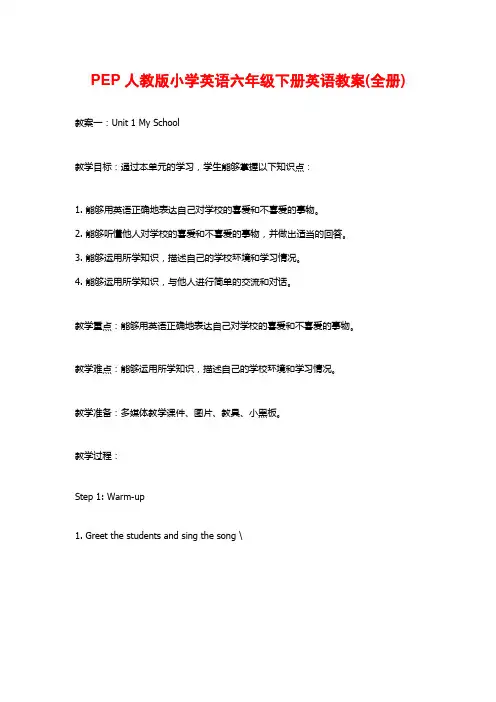
PEP人教版小学英语六年级下册英语教案(全册) 教案一:Unit 1 My School
教学目标:通过本单元的学习,学生能够掌握以下知识点:
1. 能够用英语正确地表达自己对学校的喜爱和不喜爱的事物。
2. 能够听懂他人对学校的喜爱和不喜爱的事物,并做出适当的回答。
3. 能够运用所学知识,描述自己的学校环境和学习情况。
4. 能够运用所学知识,与他人进行简单的交流和对话。
教学重点:能够用英语正确地表达自己对学校的喜爱和不喜爱的事物。
教学难点:能够运用所学知识,描述自己的学校环境和学习情况。
教学准备:多媒体教学课件、图片、教具、小黑板。
教学过程:
Step 1: Warm-up
1. Greet the students and sing the song \。

pep小学英语四年级上册教案pep小学四年级上册英语全册教案(优秀3篇)日子在弹指一挥间就毫无声息的流逝,我们的教学工作又将翻开新的一页,请一起努力,写一份教学计划吧。
相信大家又在为写教学计划犯愁了吧,问渠那得清如许,为有源头活水来,本文是勤劳的小编为家人们整编的3篇pep小学四年级上册英语全册教案,欢迎参考阅读,希望对大家有一些参考价值。
pep小学四年级上册英语全册教案篇一教学目标:1、要求充分利用教材插图提供的场景和信息帮助学生对语言内容的'理解和使用。
2、要求学生整体把握,通过教师提问,观察故事插图,听故事录音理解故事内容。
再从理解到模仿。
3、对于新词和结构,应创设情景让学生理解。
4、要让学生模仿录音的语音语调,注意发音的准确性。
教学重点:创设情景让学生理解及运用有关购物的语言知识。
教学难点:功能句的熟练掌握与运用。
教具准备:课件,头饰,图片。
教学过程:(一)组织教学Hello,students. Today ,we’ll learn Unit 3.(二)导入1、[教师拿出衣服的图片介绍] Look,they’re clothes.What are they? (学生说出图中衣服的名称)a dress,a shirt,a sweater,socks,[学习新单词] a skirt,trousers,shorts shoes,2、讲解:Every clothes has ,look .I have some shirts . This one is small. This is medium. This is large. We also call them:small (S) medium (M); large (L)3、看着图片,让学生试着回答问题。
What size do you want? (Medium) [板书] 让学生跟读教师又问:Do you have any shirts? (Yes,I do. No,I don’t.)[板书]让学生跟读。
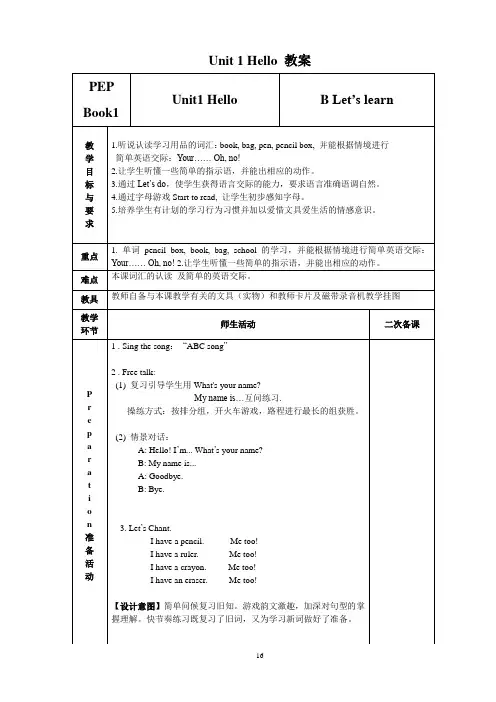
Unit 1 Hello 教案
P r a c t i c e 巩固练习1. 字母游戏:
Start to read.(第9页) 教师引导帮助学生观察、圈出相同的字母。
2. 单词游戏:
(1)找朋友:让几名同学分别拿着新授的单词卡片,另几名同学拿着单词的图片,各自记住自己的单词,如果教师说begin,
他们就可以口中边念着自己的单词,如:book... 边快速找
到自己的朋友,找到后可互相打招呼,如:Hello, book.
———_____
(2)猜一猜:根据儿童好胜的天性,可以让同学们对所学单词进行猜一猜活动,如:老师把新授的单词卡片中的任一张举在
上前比赛的两名同学的后面,让他们快速猜出是什么单词,
猜错的话可以继续往下猜,直到一名同学猜对为止,对猜对
的同学要给与表扬、奖励。
(3)数一数:教师帮助、指导学生完成课本第9页的Read and count.
2. 小组活动。
(1)小组表演:
六人一小组,将所学物品摆放在桌子上,2分钟内,小组长领导小组成员一起自由练习Let’s do 内容,教师给予指导。
(2)小组比赛:
教师运用TPR模仿各种动作让生说英语,之后交换;回答正确的同学可以为该组争得一个标志并运用TPR挑战其他小组。
【设计意图】图意结合教学法,由机械操练到意义操练;把游戏变成比赛激发学习兴趣。
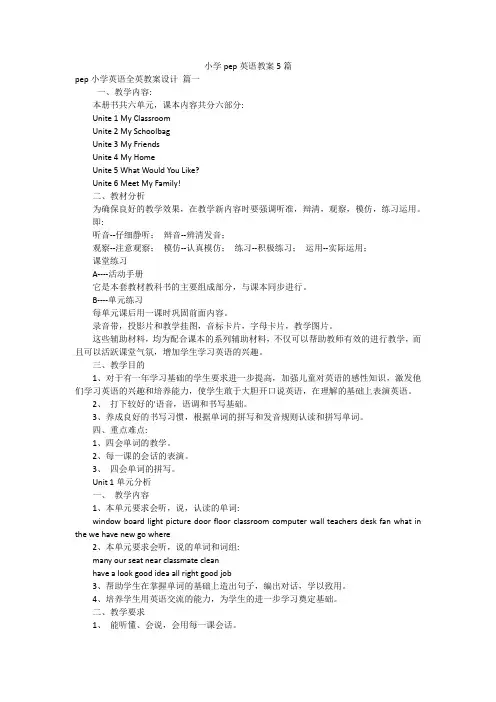
小学pep英语教案5篇pep小学英语全英教案设计篇一一、教学内容:本册书共六单元,课本内容共分六部分:Unite 1 My ClassroomUnite 2 My SchoolbagUnite 3 My FriendsUnite 4 My HomeUnite 5 What Would You Like?Unite 6 Meet My Family!二、教材分析为确保良好的教学效果,在教学新内容时要强调听准,辩清,观察,模仿,练习运用。
即:听音--仔细静听;辩音--辨清发音;观察--注意观察;模仿--认真模仿;练习--积极练习;运用--实际运用;课堂练习A----活动手册它是本套教材教科书的主要组成部分,与课本同步进行。
B----单元练习每单元课后用一课时巩固前面内容。
录音带,投影片和教学挂图,音标卡片,字母卡片,教学图片。
这些辅助材料,均为配合课本的系列辅助材料,不仅可以帮助教师有效的进行教学,而且可以活跃课堂气氛,增加学生学习英语的兴趣。
三、教学目的1、对于有一年学习基础的学生要求进一步提高,加强儿童对英语的感性知识,激发他们学习英语的兴趣和培养能力,使学生敢于大胆开口说英语,在理解的基础上表演英语。
2、打下较好的'语音,语调和书写基础。
3、养成良好的书写习惯,根据单词的拼写和发音规则认读和拼写单词。
四、重点难点:1、四会单词的教学。
2、每一课的会话的表演。
3、四会单词的拼写。
Unit 1单元分析一、教学内容1、本单元要求会听,说,认读的单词:window board light picture door floor classroom computer wall teachers desk fan what in the we have new go where2、本单元要求会听,说的单词和词组:many our seat near classmate cleanhave a look good idea all right good job3、帮助学生在掌握单词的基础上造出句子,编出对话,学以致用。
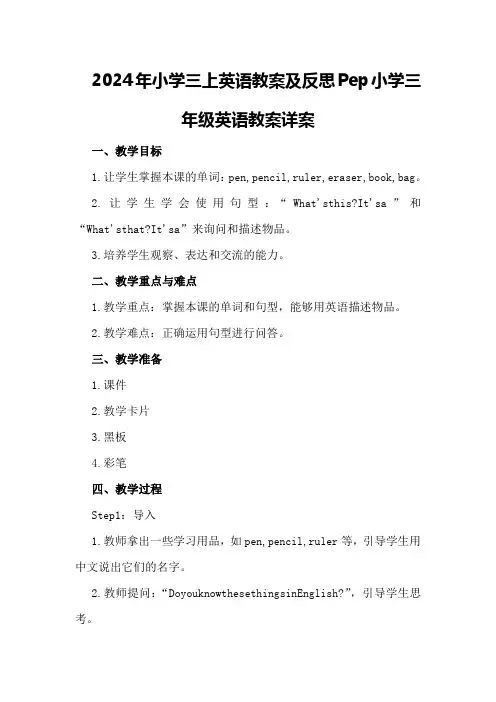
2024年小学三上英语教案及反思Pep小学三年级英语教案详案一、教学目标1.让学生掌握本课的单词:pen,pencil,ruler,eraser,book,bag。
2.让学生学会使用句型:“What'sthis?It'sa”和“What'sthat?It'sa”来询问和描述物品。
3.培养学生观察、表达和交流的能力。
二、教学重点与难点1.教学重点:掌握本课的单词和句型,能够用英语描述物品。
2.教学难点:正确运用句型进行问答。
三、教学准备1.课件2.教学卡片3.黑板4.彩笔四、教学过程Step1:导入1.教师拿出一些学习用品,如pen,pencil,ruler等,引导学生用中文说出它们的名字。
2.教师提问:“DoyouknowthesethingsinEnglish?”,引导学生思考。
Step2:单词教学1.教师展示单词卡片,逐一教授pen,pencil,ruler,eraser,book,bag等单词,让学生跟读并模仿。
2.教师通过游戏巩固单词,如“闪卡游戏”、“击鼓传花”等。
Step3:句型教学1.教师展示课件,呈现句型“What'sthis?It'sa”和“What'sthat?It'sa”,引导学生跟读并模仿。
2.教师通过情境演示,让学生理解句型的用法。
例如,教师拿出一个pen,问:“What'sthis?”,引导学生回答:“It'sapen。
”3.教师组织学生进行角色扮演,练习使用句型。
Step4:课堂活动1.游戏一:“猜猜看”教师将一些学习用品藏在身后,让学生猜猜是什么,并用句型进行描述。
2.游戏二:“快速问答”教师出示一些学习用品,学生快速用句型进行问答。
1.教师引导学生用句型描述教室里的物品,如:“What'sthis?It'sadesk.”,“What'sthat?It'sachr.”2.教师让学生回家后,用今天学的句型和家人进行互动,描述家里的物品。
小学pep英语教案优秀5篇小学pep英语教案优秀5篇1教学目标与要求:1、能听懂,会说Hello.’m?What’syourname?Myname’s?并能够在实际情景中进行运用。
2、能够听说,认读crayon,pencil,pen,eraser,ruler,pencilbox,book,bag.并能用英语介绍文具。
3、能听懂所接触的指示语,并能按照指令做出相应的动作。
A部分第一课时一、教学内容与分析1、Let’stalk本部分主要是会话学习。
通过见面打招呼,自我介绍等情景,让学生在模仿、学习、表演的基础上逐步达到自然交流与真实运用的目的。
2、Let’splay本部分让学生在游戏活动中熟练运用所学问候语及自我介绍用语。
3、Let’ssing本部分主要通过学生学唱ABCsong,让学生初步接触字母的发音,激发他们对英语学习的兴趣,从而逐步培养学生的语音,语调。
4、Let’sfindout通过找字母,让学生了解字母。
二、课前准备1、将教师用书后所附的本套教材主要人物的图片复印或剪下,涂色后制成头饰。
2、为班上学生准备出男女生常用的英文名字。
3、为Let’splay中的游戏准备相应的道具。
三、教学步骤【一】热身(Warm-up)不妨请学生说说他们在现实生活中已经了解的英语词汇或日常用语。
同时可利用我们生活中学生已经会说或较熟知的词汇如TV,CD,VCD,DVD,OK!Hi!Yeah!Bye!Cool!Wow!E-mail,cartoon等等来激发学生想学英语的兴趣和愿望。
【二】新课展示(Presentation)新课展示一:教师播放本课的歌曲“Hello”的录音,自然引出师生之间的打招呼。
(1)通过教师的自我介绍自然引出Hello,I’m?/Hi,I’m?(2)教师可戴上Sarah的头饰介绍Hello!I’mSarah.并用同样方式介绍其他人物。
(3)让学生到讲台上来,戴上Sarah,ChenJie,Mike的头饰说:Hello!I’m?(4)教师戴上WuYifan的头饰说Hi!I’mWuYifan.并与戴Sarah头饰的学生相互问好,并有意在分手时说Goodbye.(5)听录音来展示Let’stalk部分的教学内容。
PEP三年级上册英语教案教学目标:1. 学习并掌握字母 A-Z 的发音和书写。
2. 学会描述人物和物品的外观特征。
3. 学习使用简单的日常用语进行问候和自我介绍。
4. 学会用简单的句子表达自己的喜好和不喜好。
5. 通过游戏和歌曲等多种形式培养学生的英语听力和口语交流能力。
教学准备:1. 教材:PEP三年级上册英语课本。
2. 教具:录音机、黑板、白板、笔、教具卡片、图片等。
教学过程:第一课:Hello! Hello!教学目标:学习问候的基本表达方式和回答方式。
1. 热身活动 (Warm-up)- 通过与学生打招呼并问候来调动学生积极性。
2. 听力训练 (Listening)-播放录音,让学生跟读并听音判断正误。
- 强调句子的语音语调。
3. 学习新词汇 (New words)- 出示图片,教学新词汇hello、morning、afternoon、evening。
- 引导学生模仿老师和录音的发音。
4. 对话练习 (Dialogue practice)- 分组练习问候对话,帮助学生熟练掌握问候的基本句型。
5. 扩展活动 (Extension)- 引导学生制作问候卡片,互相交流问候。
第二课:My Name Is...教学目标:学习自我介绍的基本表达方式。
1. 热身活动 (Warm-up)- 复习上节课的问候,要求学生用完整的句子回答。
2. 听力训练 (Listening)- 播放录音,让学生听音回答问题。
3. 学习新词汇 (New words)- 出示图片,教学新词汇 name、is。
- 引导学生模仿老师和录音的发音。
4. 自我介绍练习 (Self-introduction practice)- 学生依次自我介绍,注意语音语调的正确运用。
5. 扩展活动 (Extension)- 模仿游戏:老师模仿一个学生的自我介绍,学生根据老师的介绍找到对应的学生。
第三课:Colors教学目标:学习基本的颜色词汇和描述物品外观的句子。
PEP六年级小学英语上册教案全册及反思目录•引言•教案一:Unit 1 Hello–教学目标–教学内容–教学步骤–教学反思•教案二:Unit 2 My Family–教学目标–教学内容–教学步骤–教学反思•教案三:Unit 3 My School Bag –教学目标–教学内容–教学步骤–教学反思•教案四:Unit 4 My Room–教学目标–教学内容–教学步骤–教学反思•总结引言《PEP六年级小学英语上册教案全册及反思》是对PEP六年级小学英语上册的教学教案进行总结和反思的文档。
本文档将会按照教学单元依次介绍每个教案的教学目标、教学内容、教学步骤以及教学反思,为教师们提供参考和借鉴。
教案一:Unit 1 Hello教学目标•学习并掌握问候语Hello、Hi、Good morning和Good afternoon的用法。
•能够准确使用问候语进行日常交际。
•能够听懂并模仿简单的日常问候对话。
教学内容•单词:Hello、Hi、Good morning、Good afternoon•日常问候对话教学步骤1.引入新课,通过播放问候视频引起学生的兴趣。
2.教师用图片和动作展示问候语,引导学生模仿。
3.学生进行角色扮演,在教师的引导下使用问候语进行对话。
4.教师播放听力材料,帮助学生听懂日常问候对话。
5.学生根据听到的对话进行回答,并模仿读对话。
6.教师布置家庭作业。
教学反思本节课通过生动有趣的视频、图片和角色扮演等教学方法,激发学生兴趣,帮助学生学习和掌握了问候语的用法。
通过听力训练和模仿对话,学生巩固了所学内容。
然而,由于时间限制,对于某些学生来说,练习的时间可能仍然不够,下次可以适当调整教学步骤,留出更多时间给学生进行练习。
教案二:Unit 2 My Family教学目标•学习并掌握家庭成员的称呼,如father、mother、brother、sister等。
•能够用英语介绍自己的家庭成员。
•能够听懂并模仿简单的家庭成员介绍对话。
小学pep英语教案优秀(通用3篇)小学pep英语教案篇一She learnt English.教学目标1.学会词汇learnt these dancer2.能听懂会说Unit 1这篇对话。
3.学习目标语句:Did your grandma learn English? Yes, she did. /No, she didn’t.4.能口头运用Did your grandma learn English?这类语句询问过去的行为,并能口头运用Yes, she did./No,she didn’t.回答。
教学重点:学会词汇learnt these dancer教学难点:运用目标语句She danced in lots of Chinese cities .Did she learn any foreignlanguages? Yes, she did. /No, she didn’t. He was a dancer .谈论过去。
教学过程:Step1.预习检测根据所给单词,补全句子。
1. Sam he isXXXXX.(short tall)2. My motherXXX sheXXX XXX.(old young)Step2.合作探究,学习课文。
1. 听课文录音,理解课文大意。
2. 小组内学习课文。
3. 师解决疑惑。
4. 学生自己读课文,找出下面问题的答案。
Who are they ?Why is she wearing these clothes?Did she learn English?Step3.巩固练习小学pep英语教案篇二一、教学内容本节课的设计是针对《义务教育课程规范实验教科书英语PEP》四年级上册Unit 2 My schoolbag Part A Let’s learn Let’s do部分。
通过本节课的学习,同学能够掌握对话A和English book, maths book, Chinese book, story-book,notebook,schoolbag这几个单词。
2024年小学英语pep公开课教案通用一、教学内容本节课选自PEP小学英语教材五年级下册,涉及章节为Unit 3 “My School Calendar”以及Unit 4 “When is Easter?”的内容。
详细内容包括:掌握有关学校活动及节日的词汇,如sports day、field trip、Easter等;运用一般现在时和一般将来时描述学校活动和计划;学会阅读和编写日历信息。
二、教学目标1. 能够听懂、会说、会认读与学校活动及节日相关的词汇。
2. 能够运用一般现在时和一般将来时描述学校活动及个人计划。
3. 培养学生合作交流的能力,提高学生的英语实际运用水平。
三、教学难点与重点1. 教学难点:一般将来时的运用,以及日历的阅读和编写。
2. 教学重点:学校活动及节日词汇的掌握,一般现在时和一般将来时的运用。
四、教具与学具准备1. 教具:PPT、卡片、日历、小奖品等。
2. 学具:英语课本、练习本、彩色笔等。
五、教学过程1. 导入:通过展示一张学校的日历,引导学生回顾已学的与学校活动及节日相关的词汇,为新课的学习做好铺垫。
2. 新课呈现:展示PPT,呈现新课词汇和句型,引导学生跟读、模仿,并进行小组合作练习。
3. 实践情景引入:设置“学校活动计划”的情景,让学生运用所学词汇和句型进行角色扮演,提高学生的实际运用能力。
4. 例题讲解:结合教材,讲解一般现在时和一般将来时的用法,并通过例句进行巩固。
5. 随堂练习:设计相关练习题,让学生进行巩固练习,及时发现问题并进行解答。
七、作业设计1. 作业题目:(1)根据所给词汇,编写一段关于学校活动的对话。
(2)用一般将来时描述你下周的计划。
答案:(1)A: What are you doing on Friday?B: We are having a sports day.(2)Next week, I will go on a field trip with my classmates.八、课后反思及拓展延伸1. 课后反思:关注学生的学习效果,反思教学方法是否有效,对学生的疑问进行解答。
PEP小学英语五年级上册《Unit 4 Story time》优秀教案及教学反思一. 教材分析PEP小学英语五年级上册《Unit 4 Story time》主要讲述了一个关于动物们参加比赛的故事。
故事中,动物们分别展示了各自的特长,最终通过合作完成了任务。
本节课的主要语言点是一般过去时的动词形式,以及一些动物的名称和特征。
通过本节课的学习,学生能够掌握一般过去时的动词形式,并能运用所学知识描述动物的特点。
二. 学情分析五年级的学生已经掌握了一般现在时和一般过去时的基本用法,对动词的不同形式有一定的了解。
但部分学生对动物的名称和特征了解不多,需要在课堂上进行补充。
此外,学生们的团队合作意识和口语表达能力有待提高。
三. 教学目标1.知识目标:–能够听懂、会说、会读故事中的动物名称和特征。
–能够运用一般过去时描述动物们参加比赛的动作。
–能够理解并运用故事中的核心句型。
2.能力目标:–能够模仿和表演故事中的对话。
–能够用英语讲述动物的特点。
3.情感目标:–培养学生热爱动物的情感。
–培养学生的团队合作意识。
四. 教学重难点•动物的名称和特征。
•一般过去时的动词形式。
•故事中的核心句型。
•一般过去时的动词形式。
•描述动物特点的语言表达。
五. 教学方法1.情境教学法:通过设置故事情境,让学生在真实的环境中学习英语。
2.任务型教学法:通过完成各种任务,提高学生的语言运用能力。
3.合作学习法:培养学生团队合作意识,提高学生的口语表达能力。
六. 教学准备1.教材:PEP小学英语五年级上册《Unit 4 Story time》。
2.课件:故事动画、图片、单词卡片等。
3.学具:动物手偶、贴纸等。
七. 教学过程1.导入(5分钟)–利用动画引入故事,吸引学生的注意力。
–引导学生复习故事中的动物名称,为新课的学习做好铺垫。
2.呈现(10分钟)–通过课件展示故事情节,引导学生跟读单词和句型。
–分组进行角色扮演,让学生模仿故事中的对话。
pep小学英语优秀教案【篇一:pep新版小学英语三上完整教案】英语三(1、2、3、4)班陆狄江2013年9月学期教学计划2345【篇二:pep人教版小学英语六年级上册(全英)教案】 unit 1 how do you go there?period oneteaching contents: part a let’s learn let’s playteaching aims:1. to enable the students to master the four skills phrases: on foot,by bike,by bus,by train,by plane,by ship,by subway2. to enable the students to ask about the ways of traffic with the following sentence patterns:how do you go to school? or how do you go tocanada…?‖and answer with―i go by…‖ teaching focus:to master the four skills phrases: by train ,by plane, by subway, by ship , by bike, on foot teaching difficulty:to differ ―subway‖ from―train‖teaching methods:communicative approachteaching aids:1. word cards2. tape recorder and tape3. multi-media playerteaching procedure:1. (warm-up)greeting: good morning , class !glad to meet you again. how are you?what day is it? what ?s the date?what‘s the weather like today?2. presentationshow a picture of bust: what‘s this? s: it‘s a bus.t: i go to school by bus. how do you go to school?(show a picture of bike and help a student to answer with ―i go to school by bike.‖)(in the same ways )teach ―by subway‖ and ―by train‖ ―by ship‖ ―by plane‖ ― on foot‖.subway: its an underground railway in a city.it travels very fast.we can see subway in hong kong, beijing, shanghai, gongzhou…explain the differences between subway and trainpay attention to the pre. ― by‖ ―on‖3. play gamesask one s to the front and stick the word cards next to the phrases written on the bb when t read the new phrases quickly and the other ss put up their cards. the one who reflect fastest and correctly is the winner.4. listen to the tape of part a let‘s learn and follow it.pay attention to the tone and pronunciation5. practice: let‘s playt offer many places (the usa. england australia hong kong shanghai guangzhou the moon…)and traffic ways (by car/ taxi/ bus… on foot)ss practice with above places and ways in pairs:a: how do you go to school?b: i go to school on foot.encourage the ss to make up as many sentences as they can.6. spelling competitionhomeworkcopy the new words and phrasesfinish page1 of the abbb design:unit one how do you go therehow do you go to school/ canada?i go to school on foot/ by subway/ bus/ train/ taxi…teaching reflection:unit1 how do you go there?period twoteaching contents: let’s try let’s talkteaching aims:1. to master the four skills sentence: ―how do you go to school? usually i go to school onfoot.sometimes i go by bike.‖2. to enable the ss to ask and answer about traffic ways and explain the simple reason whyhe or she chose this traffic way.i go to school on foot, because my home is near.3. to make the ss understand the listening material in ―let‘s try‖teaching focus:to use and write the following key sentences:how do you go to school?usually i go to school by bike. sometimes i go on foot.teaching difficult points:to write the key sentences: how do you go to school?usually i go to school on foot.sometimes i go by bike.to use adverbs of frequency: usually, sometimesteaching aids:tape recorder teaching cardsa piece of paperteaching procedure:1. (warm-up)t: good morning! how do you go to school today? what about you? do you go by bus,too?‖2. have a dictationask the ss to dictate the new words learnt in the last lesson.on foot by bus by train by plane by subway…3. letstryguide the ss to look at the pictures and askwho‘s the boy?he‘s mike.how does mike go to school?play the tape and listen:john:how do you go to school,mike?mike:i usually go to school by bike.sometimes i go 0n foot. john:is your home near our school?mike:yes.it is.j0hn:thats fine!4. (presentation)lets talkt: how do i go to school,do you know? ask me,please!draw a bike, a bus, a taxi on the bb and write the price by each picture. bus 1 yuantaxi 10 yuanencourage the ss to ask―how do you go to school?t: usually i go to school by bike, because its good exercise.sometimes i go by bus,because its cheap.it costs l yuan. sometimes i go by taxi,because its fast,but its too expensive.it costs 1o yuan.explain that we use usually and sometimes to express frequency.t: ―how does sarah go to school? listen.‖ask the s to imitate sarah‘s tone to answersarah: usually i to go school on foot. sometimes i go bike.ss read after the tape. then practice in pairs to make up the new dialogue according toeach picture.ask several pairs to act out the dialogue.5.group workread the dialogue .then practice in groups of four. they can expand their dialogue like the following:a:how do you go to school/ hometown?b:usually i go by bus.a:can you go by bike?b: yes,i can,but its too far.sometimes i go by taxi,because it‘s fast, but its expensive.what about you?a:i go to school on foot,because my home is near.6.play finding order gamesshow the following word cards and ask ss to form correct sentences.how, do , go , to , school, youi , usually, on , go , school , to , footsometimes, by, bike, go , ihomework:finish ab page2bb designunit1 how do you go therehow do you go to school?usually i go to school on foot, because it‘s near.sometimes i go by bike, because it‘s fast.period threeteaching contents: let’s readteaching aims:1. to improve reading skill2. to consolidate the traffic ways3. to improve understanding ability.teaching focus:how do we go to the park?it‘s easy.how to finish answering the questions in the bookteaching difficult points:how to express the different ways to a placeteaching aids:tape recorder a piece of paper masks of zhang peng and sarahteaching procedure:1. reviewfree talk2. dictationhow do you go to school?usually i go to school on foot.sometimes i go by bike. what about you?3. review different placest: this is a very nice place. there are many students and teachers. there are many rooms, such as classroom, art room, music room… what‘s it?it‘s a beautiful place. many people like to play in it. there are nice flowers, trees and grass. there are toys. what is it?it‘s a park.4. presentationt: where is my home? do you want to know?describe with different traffic ways anduse ―first‖ ―next‖ ―then‖ .it‘s a little far from here. first i go to zenbu bus stop on foot. then i can go by the no.74bus to the east bus station... we live on the ninthfloor,room902.explain ―then‖5. t ask individual :where is your home?is it near the park? which floor?in pairs practice above questions6. play the tape and students follow it.ask: how can we go to sarah‘s home?how can they go to the park?finish answering the questions, then check the answers.7. practiceread the text. boys to be zhang peng,and girls to be sarah.work in pairs to read the dialogue.ask several pairs to act out.8. make up new dialogueshomework:do page 5 in abbb design:how do we go to the park?it‘s easy.which floor?the fifth floor, room 5aperiod fourteaching contents: let’s learn and let’s playteaching aims:1.to master the phrases: stop at a red light. wait at a yellow light. go at a green light.5. to know some traffic rules about traffic lightsteaching focus:to understand the traffic lights commands and do the action: stop at a red light.wait at a yellow light.go at a green light.teaching difficult points:the meaning of the three traffic lights and do the correct action of the commandsteaching aids:tape recordera flash card of traffic lightsword cardsteaching procedure:【篇三:新版pep小学英语三年级上册教学设计unit3】 unit 3look at me12345。